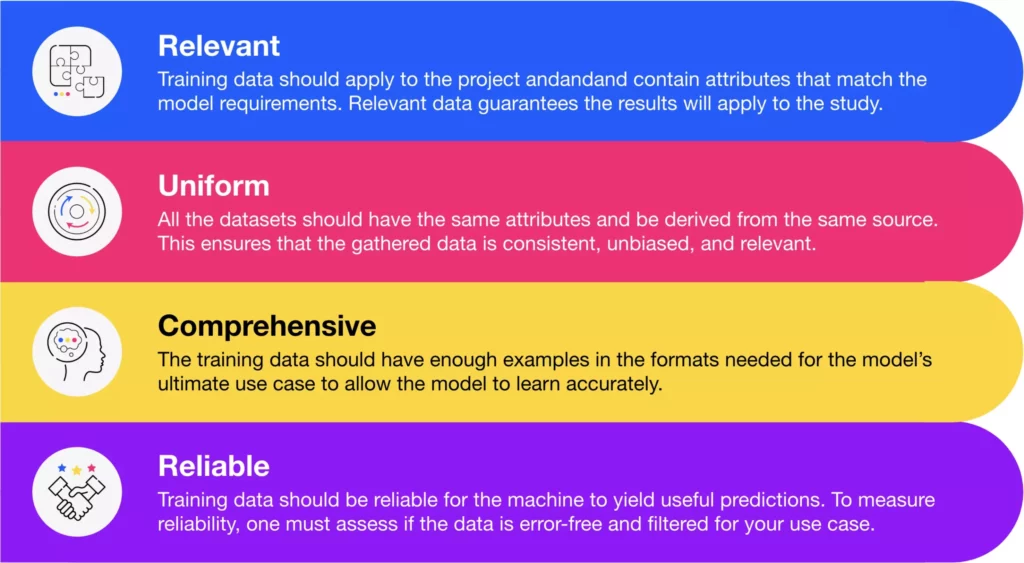Industry Knowledge
An Introduction to Machine Learning Training Data
Exploring the potential of machine learning training data.
Machine Learning (ML) is a field that has tremendous potential. Powered by quality training data and AI training data, it enables us to automate tasks that previously required human intelligence, allowing us to better utilize technology and manpower to create new ideas and applications. This ability to make complex tasks more efficient has many advantages, but one particular benefit is the creation of machine learning training data.
With the rapid growth of artificial intelligence (AI), ML applications have become a prominent part of many businesses, gaining worldwide funding of $28.5 billion1 during the first quarter of 2019. Large amounts of investment are poured into ML models and the gathering of quality AI training data, making their success naturally crucial for any company. That’s why it has become increasingly important to feed ML models with high-quality training data that can maximize, or even guarantee, accuracy and success.
Defining Machine Learning Training Data
ML, or AI training data, is the dataset fed to an AI application for it to make correct decisions. Known as a training dataset or learning set, it’s simply used to train any machine learning model to perform a specific task with high accuracy.

Machine learning datasets can be classified as either labeled or unlabeled data. Labeled data is used in supervised learning while unlabeled data is used in unsupervised learning2.
The Importance of Quality Training Data in Machine Learning
Proper and continuous machine learning training data is essential to those using machine learning algorithms. When someone wants to use a specific algorithm, they need access to sufficient quality training data to assist their algorithm to perform optimally with minimal errors.
Training data is a critical component of any machine learning model. Therefore, to ensure the accuracy of an ML model, it is crucial to collect and annotate quality training data. Without it, a machine learning model can give faulty predictions that can affect the project's success. Simply put: garbage in, garbage out.
For instance, to train an ML model as a driver monitoring system for autonomous vehicles, you’ll need large amounts of quality training data to analyze multiple factors such as facial expressions, road conditions, movement patterns, and driving environment to ensure the driver's safety. Without this proper training data, self-driving cars could not perform reliably, safely, securely, and efficiently.
Machine learning training data in retail technology, on the other hand, can help companies achieve customer satisfaction while increasing their profits. By utilizing machine learning, retail technology can provide a flexible workforce solely dedicated to real-time data tagging, a comprehensive quality control infrastructure, and a blended learning experience for agents.
These industries show that quality training data is one of the most significant factors in determining the overall accuracy and performance of the finished product. The better quality training data you can get, the greater the potential for your algorithm to learn from it.
How Much AI Training Data is Enough?
Based on the complexity and outcome of the project, a model might need a vast amount of data with diverse samples that cover various aspects of the use case and prevent data bias. The more quality training data you have to train your model with, the more accurate it becomes.
Keep in mind that a good quality training dataset can make the difference between an average performance and a top-performing model. If some of the datasets aren’t as high quality as the others, it may later affect overall performance. There are parameters that must be followed to ensure that the data is up to par with the best standards.
Characteristics of Quality Machine Learning Training Data
Thanks to the recent boom in computer technology and the growth of data science, we're able to collect more and more information, which is where quality training data comes into play. AI training makes sense of vast amounts of data that humans cannot understand on their own.
To further understand what makes training data good, let’s go through a few traits of quality training data3:

The Answer is Us
With machine learning, the importance of training data cannot be understated. Unlike most other types of data, which are static in nature, your AI training data is constantly changing.
This is where TaskUs comes in.
With over a decade of experience in data collection and annotation, we’ve mastered the best practices when it comes to AI data training. We’ve stepped in and used our crowdsourced data collection to gather diverse and unbiased data across different demographics. Launching TaskVerse is the next step to getting high-quality data while working with individuals from diverse backgrounds.
Generating an accurate representation of 25,000 data points from 9 ethnic groups of varying ages and genders results from our hard work, all thanks to our Teammates and Taskers.
Download the complete case studies, On-demand Crowd Image and Video Data Collection and Real-time Image Annotation for a Retail Tech Developer, to learn how we could lend a hand in AI training and data annotation.
References

We exist to empower people to deliver Ridiculously Good innovation to the world’s best companies.
Services







